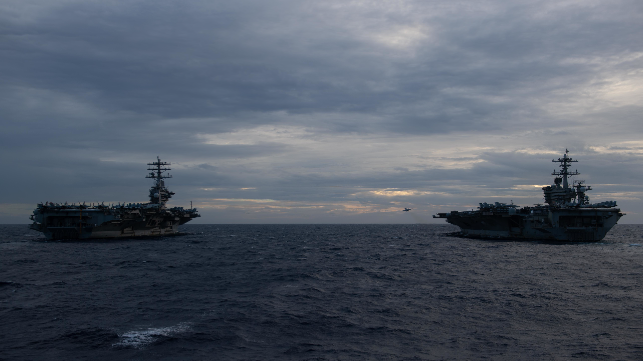Top Officer Warns U.S. Advantage is "Eroding" in the Western Pacific

China's navy has been modernizing at a rapid clip for years, and its development shows no sign of slowing. In testimony on Tuesday, commander of Indo-Pacific Command Adm. Philip Davidson told the Senate Armed Services Committtee that if the U.S. Navy does not increase its forward-deployed presence in the Western Pacific, it risks being outclassed by a growing number of sophisticated Chinese warships.
The PLA Navy is already the largest in the world by fleet size, and its qualitative capability is improving quickly. It commissioned more than 25 major ships in 2020 alone, including surface combatants, amphibs and two nuclear-powered subs. By 2025, the U.S. Navy projects that China will be able to field six amphibs, three carriers (of varying sophistication) and more than 50 advanced multirole surface combatants in the region.
“How do you feel about our ability right now to defend Taiwan [from China]?” Senator Roger Wicker (R-Mississippi) asked Davidson.
“I think our conventional deterrent is actually eroding in the region,” Davidson responded. “It’s because of the vast advances . . . the Chinese have undertaken in both terms of capacity over the past twenty years and, in the next few years, the improvements they will make."
The solution, he suggested, is in adding more forward-deployed assets. "Perfect speed is being there [beforehand]," he said. "If we don't make changes in our posture forward, it will demonstrate that the Chinese have much greater capacity than we have."
Allied navies (Japan and Australia) help to offset the deficit in ship counts, but Davidson warned that if the U.S. Navy needs to deploy more assets than are currently available in 7th Fleet, there will be a wait.
"The important factor here is time. It takes almost three weeks to respond from the West Coast of the United States and 17 days to respond from Alaska to get to the first island chain," said Davidson.
Restoring the balance will take time and money to cover needs in Indo-Pacific Command - like more long-range missiles and air defense radar stations, plus more funding to support operations in the region. Last year, the defense budget included $2.2 billion for the Command's Pacific Deterrence Initiative (PDI), and Davidson confirmed that funding its needs might mean hard choices about redirecting resources from elsewhere in the base defense budget.
